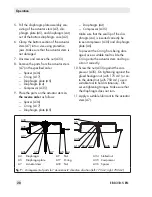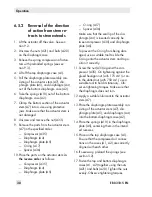
EB 8310-5 EN
41
Decommissioning and disassembly
9 Decommissioning and disas-
sembly
Risk of bursting in the actuator.
Actuators are pressurized. Improper opening
can lead to actuator components bursting.
Before starting any work on the actuator, de-
pressurize all plant sections concerned and
the actuator.
Risk of personal injury due to preloaded
springs.
Actuators with preloaded springs are under
tension. They can be identified by the long
bolts protruding from the bottom of the actu-
ator.
Before starting any work on the actuator, re-
lieve the compression from the preloaded
springs (see section 9.3).
9.1 Decommissioning
To decommission the actuator for service and
repair work or disassembly, proceed as fol-
lows:
1. Put the control valve out of operation.
See associated valve documentation.
2. Disconnect the pneumatic air supply to
depressurize the actuator.
9.2 Removing the actuator
from the valve
1. Put the control valve out of operation.
See associated valve documentation.
2. Undo the clamps of the stem connector
(A26/27).
3. Loosen the stem connector nut (9) and
lock nut (10).
4.
Removing actuators with "stem ex-
tends" action with/without preloaded
springs:
to undo the ring nut (A8), apply
approx. 50 % signal pressure to open the
valve.
5. Unscrew the ring nut (A8) on the valve
bonnet (2).
6. Disconnect the signal pressure again.
7. Remove the ring nut (A8) and actuator
from the valve.
8. Fasten the lock nut (10) and stem con-
nector nut (9) on the valve.
9.3 Relieving the spring com-
pression in the actuator
1. Undo the short nuts (A21) and bolts
(A20) on the diaphragm cases (A1, A2).
2. Undo the the long nuts (A23) and bolts
(A22) on the diaphragm cases evenly in
a crisscross pattern.
DANGER
!
WARNING
!
Summary of Contents for 3277
Page 46: ...46 EB 8310 5 EN...
Page 47: ...EB 8310 5 EN 47...








































